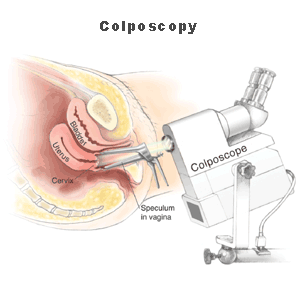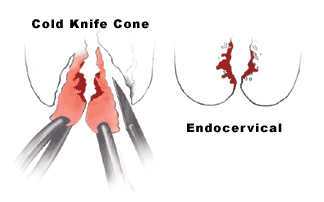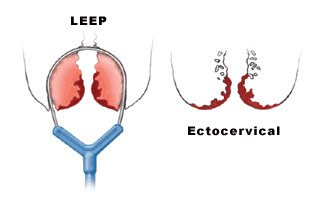Treatment

The biology of cervical cancer is one of the best-characterized of all cancers. Its precursor, cervical intraepithelial neoplasia (CIN), is both detectable and quantifiable, which presents many opportunities for evaluation or early treatment, intervention and eventually, for cancer prevention.
Specific treatment for HPV lesions of the cervix will be determined by your physician based on:
- Your overall health and medical history
- Extent of the lesion
- Your tolerance for specific medications, procedures, or therapies
- Expectations for the course of the lesion
- Your opinion or preference

Surgical Treatments
If your doctor determines that you have a high grade cervical lesion, he or she may advise you to have the lesion removed. The two most common methods of removing cervical lesions are by procedures called a LEEP or Cold Knife Cone. Both procedures are quick and typically have a quick recovery time.
The LEEP (Loop Electrosurgical Excision Procedure) can be performed either in the doctor’s office or as an outpatient procedure in the operating room. The procedure starts much like a regular pelvic exam. You will need to lie down on an examining table and put your feet in the stirrups. Next, an instrument called a speculum is inserted into your vagina to hold your vaginal walls open so your physician can view the inside of the vaginal walls and the cervix. A dilute vinegar solution is applied to the cervix to make the abnormal cells visible. An instrument called a colposcope will be used to visualize the cervix. The cervix is numbed with local anesthesia. An electrically charged loop made of thin wire is inserted through the speculum and up to the cervix. As the loop is passed across the cervix, it cuts away a thin layer of surface tissue, removing the abnormal cells. This tissue is then sent to the lab to be tested for abnormal cells. In some instances, a medicated paste is applied to the area to prevent bleeding. If all of the abnormal cervical tissue is removed, no further surgery is needed, though abnormal cells may recur in the future.
Your doctor will give you instructions for recovering at home, including using pads to collect any discharge, avoiding strenuous activity for 48 hours, and abstaining from sexual intercourse for three to four weeks. You also should avoid tub baths, tampons or douching. Over the counter pain relievers can be used to relieve cramping.
The Cold Knife Conization is performed in the operating room, using a scalpel. You will be sedated using anesthesia. You will lie on a table and place your feet in stirrups to position your pelvis for examination. An instrument called a speculum will be inserted into your vagina to hold your vaginal walls open so your physician can view the inside of the vaginal walls and the cervix. The doctor will cut out a small, cone-shaped sample of tissue from the cervix. Pathologists will examine it under a microscope for any signs of cancer or abnormal cells. The procedure may be used to treat moderate to severe dysplasia (CIN II or III). Very early stage cervical cancer (stage 0 or IA1) may also be treated with this procedure. Abnormal cells from the cervical canal, including adenocarcinoma in situ, may be diagnosed, and sometimes treated with cold knife conization.
Your doctor will give you instructions to prepare for the procedure and recover at home. Before the procedure, you may need to fast for six to eight hours. For two to three weeks after the procedure, you may have heavy, bloody, or a yellow-colored discharge. You may experience some cramping or discomfort for a week or so. Avoid sexual intercourse, douching and use of tampons for about four to six weeks.

Therapeutic HPV Vaccines
Through the efforts of a team of investigators in the Johns Hopkins Center for Cervical Dysplasia, several clinical trials testing immune therapies for HPV disease are currently open. The development of these HPV-targeted immune therapies, chronicled in over 20 publications in leading biomedical research journals, emerged from a team of translational investigators in three different disciplines: immunology, gynecologic pathology, and gynecology. The initial generation of HPV vaccines involved the use of targeting signals that made HPV antigens more visible to the immune system. In animal models, these vaccines made strong immune responses against HPV. In addition, strategic collaborations with a number of companies are paving the way to the development of combination immunotherapies with even greater potential efficacy. It is our goal to develop a combinatorial HPV immunotherapy approach that could be applied to all women with established HPV infections, that would ultimately eliminate the need for the complex and expensive screening, long-term follow-up, and surgical interventions currently employed to manage HPV disease. The identification of specific HPV antigens makes this disease an ideal model to develop antigen-specific immunotherapies for other chronic viral diseases, such as hepatitis, and ultimately, non-virus-associated cancers.
